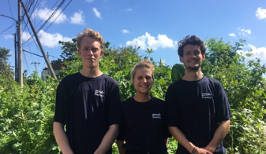Research on riverine plastic waste in Indonesia
In Q4 2019, I travelled to Indonesia to do research on riverine plastic waste for the Department of Water Resources. I was accompanied by two fellow students, Wouter and Eva.
Accumulation of plastic litter is one of the biggest problems on planet earth. The issue is causing harm to marine wildlife as well as the well-being of humans. Since the emergence of the commercial plastic industry in the 1950s, humanity has used the marine environment to dispose garbage. The majority of the solid waste ends up in the ocean, either directly or indirectly via for example run-off. At present, riverine litter debris is getting significantly less attention than pollution of the open waters. However, freshwater systems provide the main transport for land-based rubbish to the sea.
The principle purpose of my thesis was to generate a clear sight on the composition of riverine plastic waste in Bali and identify the sources from which the litter originates based on use purpose. Additionally, the waste management system of the island was thoroughly investigated. Plastic samples were quantified and characterized at eight different river sites using three distinctive fieldwork methods: trawling, visual counting and riverbank sampling. Plastic particles were sorted using three different technique; secondary- riverbank- and fragment sorting. The Ocean Cleanup supported us with Manta Trawls and Deltares shared their knowledge and relevant data with us!
During a time span of three weeks, almost 40 kg riverine waste was analysed. Distinguishing the four different river trajectories, a significant difference in plastic component was discovered. The vast majority off all the sampled plastic waste in the four river trajectories were Multilayer and PS plastics, with nearly every item in these plastic types serving the purpose of packaging, drinks or food transportation. This should be taken into consideration when thinking of mitigating measures for plastic pollution in Indonesia’s rivers.
Besides conducting research, we managed to plan multiple trips during the weekends. The three of us visited the cultural centre of Bali, Ubud. In a different weekend, we went on a boat trip to Nusa Lembongan where we did a dive and snorkelling tour with the goal to spot Manta Rays, and we did! During our last weekend, we climbed two famous volcanos: Mt. Batur and Mt. Abang. Next to the great adventures, Eva and I often rented surfboard early in the morning to start the day! All in all, it has been a great experience I will never forget.
If you’ve any questions about my time in Bali, feel free to contact me!
Diederik Westerkamp
